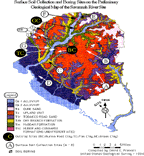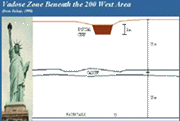Consortium for Risk Evaluation with Stakeholder Participation

|
CURRENT CRESP EFFORTS TO INFORM BETTER POLICY Responsive Science: Forging Regulatory Resolution at DOE Sites |
New scientific data and technology can release both regulators and regulated entities to explore new approaches to complex or chronic regulatory problems. The resulting collaboration can result in more timely, more cost-effective and protective regulatory compliance requirements. In a word, better risk information can, when it is credible and targeted, facilitate risk-based compliance. This is a major finding of the Consortium for Risk Evaluation with Stakeholder Participation.
This university-based interdisciplinary research effort has generated some key examples of how new risk information is improving the regulatory environment in some specific instances. We want to share the information and the processes it is opening up to help expedite sound remediation at several large DOE sites.
The following presentations and posters, prepared by CRESP researchers, address and are relevant to the role of science in policy making.
Presentations:
|
|
Posters
A New Approach to Assessing Ecological Health: Developing an Index of Biological Integrity with Insects at Hanford
Diana Kimberling, James Karr View poster
Biomonitoring and Bioindicators for Human and Ecological Health
Joanna Burger View poster
CRESP Structure Defined
Charles Powers, Brenna Smith View poster
Development of Problem Solution: Tools for Bioavailability
Lynne McGrath, Keith Cooper, Kristie Ellickson Blake Hart, Paul Lioy View poster
Long Range Planning for Stewardship at DOE Sites
Karen Lowrie View poster
Mapping Air Polutants at Hanford’s Tank Farms Using Optical Remote Sensing
Ram Hashmonay, Michael Yost, Robert Crampton View poster
Policy Analysis and Clinical Research on Occupational Beryllium Exposure at DOE Sites
Raphael Ponce, Tim Takaro, Scott Bartell, A. Jabbour, Kathy Ertell, John Abbotts,
Scott Barnhart, Elaine Faustman View poster
Structure and Function of Occupational Health Services at 10 DOE Sites
Mary Salazar, Tim Takaro, Kath Ertell, Michael Gochfeld, Sally O’Neill, Scott Barnhart View poster
Return to HOME page

 Improving DOE Worker Health Risk Identification and Protection.
Improving DOE Worker Health Risk Identification and Protection. 

